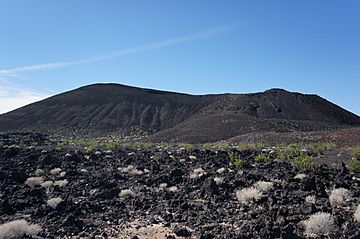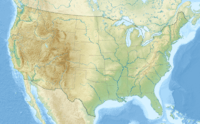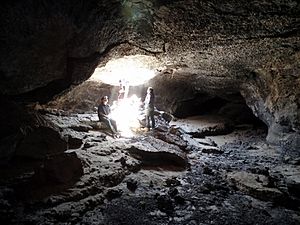Pisgah Crater facts for kids
Quick facts for kids Pisgah Crater |
|
|---|---|
 |
|
| Highest point | |
| Elevation | 2,545 ft (776 m) NAVD 88 |
| Prominence | 353 ft (108 m) |
| Geography | |
| Geology | |
| Mountain type | Cinder Cone |
Pisgah Crater, also known as Pisgah Volcano, is a young volcano in the Mojave Desert in California. It is a type of volcano called a cinder cone, which means it's shaped like a cone and made of volcanic ash and rocks. Pisgah Crater sits on top of a flat area made of hardened lava.
This volcano is located between the towns of Barstow and Needles, California in San Bernardino County, California. It's about 2.5 miles (4 km) south of the famous U.S. Route 66 and Interstate 40. The town of Ludlow is to its east. Pisgah Crater used to be taller, at 2,638 feet (804 meters) high. But because of mining, its height has been reduced to 2,545 feet (776 meters).
Contents
Mining and Its Impact
Pisgah Crater was once home to the Mount Pisgah Volcanic Cinders Mine. This mine dug up volcanic rock called pumice for different uses. One main use was to create railroad ballast, which are the crushed rocks used under train tracks. The Santa Fe Railroad used these rocks.
Today, Can-Cal Resources Limited owns the mountain. This company looks for valuable minerals in California. Mining has greatly changed the look of Pisgah Crater. The very top of the mountain has been removed. The sides, which were once smooth and even, now look rough and uneven.
Even now, people sometimes quarry the mountain for cinder products. Interestingly, sand from Pisgah Crater was used in the movie Letters from Iwo Jima. It helped make the movie scenes look like the black sands of Iwo Jima.
Exploring Pisgah Crater
Pisgah Crater rises about 321 feet (98 meters) above the desert ground around it. Its base is about 1,600 feet (488 meters) wide. Over time, it has lost much of its original cone shape. This is due to both natural erosion and the ongoing mining operations.
The mountain has many lava tubes, which are like natural tunnels formed by flowing lava. People who enjoy caving often visit these tubes. The most famous one is SPJ Cave, which is about 1,300 feet (400 meters) long.
Pisgah Crater is part of the Basin and Range Province. To the north, you'll find the Mojave Valley and the Cady Mountains. The Rodman Mountains are to the west. To the south are the Lava Bed Mountains, and the Bullion Mountains are to the southeast.
Visiting the Area
Most of Pisgah Crater and the lava fields around it are on private land. However, the lava tubes are still a popular spot for caving because they are easy to reach. To the east of the crater is Lavic Siding, a historic train stop. Beyond that is the Mojave National Preserve, a large protected area.
Geology of the Volcano
Scientists are not completely sure when Pisgah Crater last erupted. Some believe it is the youngest of four cinder cones in the Lavic Lake volcanic field. There might have been volcanic activity here as recently as 2,000 years ago. However, other scientists think the last eruption happened much earlier, perhaps 20,000 to 50,000 years ago.
It's hard to get an exact date for Pisgah Crater's eruptions. The volcano is too young for a common dating method called potassium-argon dating. This method works best for rocks older than 100,000 years. Also, no burned wood or other organic material has been found for radiocarbon dating.
Recently, a method called argon-argon dating suggested the most recent lava flow is about 18,000 years old. Another method, chlorine surface exposure dating, gave a similar age of about 22,500 years.
Lava Flows and Rocks
The lava flows from Pisgah Crater stretch about 11 miles (18 km) to the west and 5 miles (8 km) to the southeast. This lava is mostly basalt, a dark, fine-grained volcanic rock. Much of it has a smooth, ropey texture called pahoehoe lava. Some of it is also a'a lava, which is rough and blocky.
These lava flows contain many lava tubes and caves. The cinder cone itself looks reddish, orange, or brown in its upper parts. This color comes from a process called oxidization, where the rocks react with oxygen.
Pisgah Crater is a very popular place for geology students to visit and learn. On some weekends, you might see university classes or groups of professionals studying the mountain. Mining and geological surveys also happen there from time to time.
Eruptive History
Pisgah Volcano has erupted at least three times. Each eruption emptied the magma chamber below the volcano. All three eruptions produced a type of basalt rock called porphyritic basalt. This means the rock has larger crystals mixed in with smaller ones.
The first eruption created the large lava fields you can see from Interstate 40. Scientists believe the cinder cone itself formed around this time. The second eruption also produced large lava flows. The third and final eruption created a lot of tephra, which are pieces of rock and ash thrown into the air by a volcano. Most of the cinder cone we see today is made of this material from the last eruption.
What the Lava is Made Of
The lava around Pisgah Volcano is made of both a'a and pahoehoe types. It contains a lot of olivine, a green mineral that turns into a reddish-brown mineral called iddingsite when it weathers. It also has much plagioclase, another common mineral in volcanic rocks. Near the cinder cone, you can find large amounts of gypsum, a soft mineral that coats the rocks.




